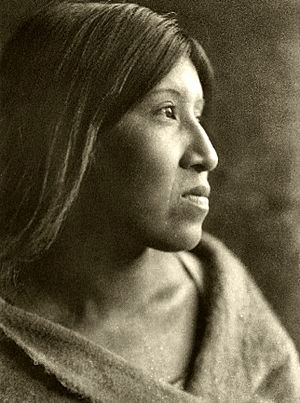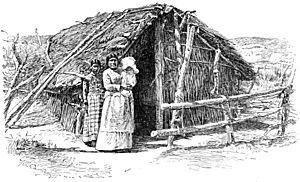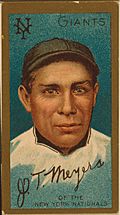Cahuilla facts for kids

Desert Cahuilla woman by Edward S. Curtis, 1926
|
|
| Total population | |
|---|---|
| 2010: 4,238 alone and in combination | |
| Regions with significant populations | |
| Languages | |
| English, Spanish, Cahuilla language | |
| Religion | |
| Christianity (Roman Catholic, Moravian, Protestant), and traditional tribal religion | |
| Related ethnic groups | |
| Cupeño, Luiseño, Serrano, and Tongva |
The Cahuilla people, also known as ʔívil̃uqaletem, are a Native American group. They live in the inland parts of southern California. Their traditional lands covered about 2,400 square miles (6,200 square kilometers). This area was in the center of Southern California. It stretched from the San Bernardino Mountains in the north to Borrego Springs in the south. To the east was the Colorado Desert, and to the west were the San Jacinto Plain and the Palomar Mountains.
Contents
Language and Name
The Cahuilla language belongs to the Uto-Aztecan language family. In 1990, only about 35 people spoke Cahuilla, even though there were 800 Cahuilla people. This means the language is in great danger of disappearing. Most speakers are older adults.
In their own language, the Cahuilla call themselves ʔívil̃uqaletem. Their language is called ʔívil̃uʔat. They also call themselves táxliswet, which means 'person'. The name "Cahuilla" was given to them by outsiders. It likely comes from the Cahuilla word kawi'a, meaning "master."
Ancient Times
Old stories from the Cahuilla say that when they first came to the Coachella Valley, there was a very large lake there. Geographers call this lake Lake Cahuilla. The Colorado River fed this lake. However, the lake dried up before the year 1700. This happened because the river changed its path many times. In 1905, a break in a levee created the much smaller Salton Sea in the same area.
The Cahuilla people lived off the land. They used many native plants. One important tree was the California fan palm. They used its fruits for food. The Cahuilla also used palm leaves to make many things. These included basketry of different shapes and sizes, sandals, and roofs for their homes. The Cahuilla lived in smaller groups compared to some other tribes.
History of the Cahuilla
The Cahuilla first met Europeans in 1774. This was when Juan Bautista de Anza was looking for a trade route. He wanted to connect Sonora (in Mexico) with Monterey (in California). The Cahuilla lived far inland. Because of this, they did not have much contact with Spanish soldiers or missionaries. Many Europeans thought the desert was not valuable and tried to avoid it.
The Cahuilla learned about Spanish missions and their culture from other Native Americans. These were Indians who lived closer to missions in San Gabriel and San Diego. The Cahuilla helped the owners of the Rancho San Bernardino. They provided vaqueros (cowboys) to work there. They also helped protect the ranch's animals from raids by other tribes.
The Cahuilla did not meet Anglo-Americans until the 1840s. Chief Juan Antonio was a leader of the Cahuilla Mountain Band. In 1842, he allowed a traveler named Daniel Sexton to enter areas near the San Gorgonio Pass. The Mountain Band also helped a U.S. Army group. This group was led by Lieutenant Edward Fitzgerald Beale. The Cahuilla defended them from attacks by Ute warriors.
During the Mexican–American War, Chief Juan Antonio led his warriors. They joined Californios (people of Spanish descent in California) led by José del Carmen Lugo. They fought against their old enemies, the Luiseño people. This fight happened after the Luiseño had killed 11 Californios. The combined forces attacked and many Luiseño warriors were killed. This event is known as the Temecula Massacre of 1847.
After the war with Mexico, the U.S. promised to respect Mexican land rules. These rules included recognizing Native American rights to live on certain lands. However, European-Americans started moving onto Indian lands more and more. This became a big problem after the U.S. took over California.
In the 1850s, many European-American settlers arrived because of the California Gold Rush. This put more pressure on the Cahuilla. In 1851, Juan Antonio led his warriors to stop a group of bandits called the Irving Gang. These bandits had been stealing from the San Bernardino Valley. After this, Juan Antonio and his people moved east. They settled in a village called Saahatpa.
The Cahuilla also had conflicts with the nearby Cupeño tribe. In November 1851, the Garra Revolt happened. The Cupeño leader Antonio Garra tried to get Juan Antonio to join his revolt. But Juan Antonio was friendly with the Americans. He helped capture Antonio Garra, which ended the revolt.
In 1852, the California Senate did not approve a treaty. This treaty would have given the Cahuilla control of their lands. Some tribal leaders then started attacking settlers and soldiers. Juan Antonio did not take part in these attacks.
To encourage the building of the railroad, the U.S. government divided the land. They gave the Cahuilla every other one-mile-square section. In 1877, the government set up reservation boundaries. This left the Cahuilla with only a small part of their original lands.
Over the last 100 years, many Cahuilla have married people from other groups. Today, many Cahuilla tribal members have mixed ancestry. This includes Spanish and African American heritage. People who grew up with the tribe's customs and feel culturally Cahuilla can become official tribal members. Each tribe has its own rules for who can join.
The Cahuilla Today
Today, Palm Springs and the areas around it are growing very fast. The Agua Caliente Band of the Cahuilla is very important to the local economy. They run many businesses. These include leasing land, hotels, casinos, and banking.
The Agua Caliente Indian Reservation covers about 126.7 square kilometers (48.9 square miles). It includes parts of Palm Springs, Cathedral City, and Rancho Mirage. In 2000, over 21,000 people lived on the reservation. However, only a few of them were registered tribal members.
The Morongo Band of Mission Indians is also part of the Cahuilla nation. They operate the Morongo Casino, Resort & Spa. They also run the Hadley Fruit Orchards in Cabazon. The Morongo Casino is one of the biggest Indian casinos in the United States. The Morongo Indian Reservation is in northern Riverside County. The cities of Banning and Cabazon partly extend onto the reservation. The reservation has a land area of about 127.08 square kilometers (49.07 square miles). It has 954 residents, most of whom are Native American.

There are also smaller Cahuilla bands in Southern California:
- The Augustine Band in Coachella.
- The Cabazon Band in Indio.
- The Cahuilla Band in Anza.
- The Los Coyotes Band in Warner Springs (San Diego County).
- The Ramona Indian Reservation in Pine Meadow.
- The Santa Rosa Indian Reservation in Pinyon.
- The Twentynine Palms Band in Twentynine Palms, Indio, and Coachella.
- The Torres-Martinez Band in La Quinta, Coachella, Thermal, Mecca, and Oasis.
- The Mission Creek Reservation in Desert Hot Springs.
The Torres-Martinez tribe has offices in many places across Southern California. They offer help to their members. This is because many Cahuilla moved for farming and factory jobs in the late 1900s.
Some Cahuilla tribes, like the Las Palmas band, used to live in the Palm Desert area. This was before land developers bought their tribal land. The number of descendants from these tribes is not known. The Montoya family, who say they have some Cahuilla heritage, are important in local business and politics.
The Cahuilla people today have a mixed background, like many other Americans. They have mixed with European (especially Anglo-American and Spanish), African American, and Asian-American people. This includes descendants of Chinese railroad workers and Filipino farm workers. They have also mixed with other tribal groups, like Apache migrant workers. Some Cahuilla families continue to marry people from local populations. Others try to marry within Native American tribes.
Official Cahuilla Tribes
Experts have divided the Cahuilla into "Mountain," "Desert," and "(San Gorgonio) Pass / Western" groups. Today, there are nine reservations in Southern California that are home to Cahuilla bands. These are in Imperial, Riverside, and San Diego counties. These are the lands of federally recognized tribes.
The Cahuilla bands (sometimes called "villages") are:
Pass Cahuilla (or Western Cahuilla)
These groups live around the San Gorgonio Pass, mainly in Palm Springs and Palm Desert.
- Agua Caliente Band of Cahuilla Indians: Their main clans include the Kawasic (meaning "fox" or "rock" people) and Painakic ("People of Daylight"). Their headquarters are in Palm Springs, California. The Spanish named it Agua Caliente (hot water) because of the hot springs.
- Morongo Band of Cahuilla Mission Indians: This band includes Cahuilla clans like Wanikik and Kawasic. It also has members from the Serrano, Cupeño, Luiseño, and Chemehuevi tribes. Their headquarters are in Banning, California.
- Mission Creek Band: This group includes Cahuilla clans like Kilyinakiktum and Wanikik. It also has mixed Cahuilla-Serrano clans, Serrano, and Cupeño people. Their headquarters are in Desert Hot Springs, California, near Mission Creek.
Mountain Cahuilla
These groups live in the Santa Rosa and San Jacinto Mountains.
- Cahuilla Band of Mission Indians of the Cahuilla Reservation: Their main clan is the Natcutakiktum ("Sand People"). Their headquarters are in Anza, California.
- Los Coyotes Band of Cahuilla and Cupeno Indians: This band includes the Wiwaiistam ("Coyote People") and Cupeño people. Their headquarters are in Warner Springs, California.
- Ramona Band of Cahuilla Mission Indians: Their main clan is the Apapatcem ("Medicine People"). Their headquarters are in Anza, California.
- Santa Rosa Band of Cahuilla Indians: This band was originally dominated by the Costakiktum and Natcutakiktum clans. They also include other clans like Pauatiauitcem and Temewhanic. Their headquarters are in Hemet, California.
Desert Cahuilla
These groups live in the deserts of the northern Lake Cahuilla area.
- Augustine Band of Cahuilla Indians: Their main clan is the Nanxaiyem. Their headquarters are in Coachella, California.
- Cabazon Band of Mission Indians: This band includes many clans like Kawisiktum and Kaunukalkiktum. The Kauwicpameauitcem clan was very important here, led by Chief Cabazon. Their headquarters are in Indio, California.
- Torres-Martinez Desert Cahuilla Indians: Their own name means "Deer Moon Among the Palms." They include clans like Panakauissiktum and Palpunivikiktum. They also include Chemehuevi Indians. Their headquarters are in Thermal, California.
Notable Cahuilla People
- Juan Antonio (1783-1863), a major chief of the Mountain Cahuilla.
- Ramona Lubo (1865-1922), a famous basket maker.
- Marigold Linton (born 1936), a cognitive psychologist.
- John Tortes "Chief" Meyers (1880–1971), a Major League baseball catcher.
- Katherine Siva Saubel (1920–2011), who worked to save the Cahuilla language.
- Gerald Clarke, an artist and educator.
- Tahquitz, a spirit from Cahuilla legends.
See also
 In Spanish: Cahuilla para niños
In Spanish: Cahuilla para niños





